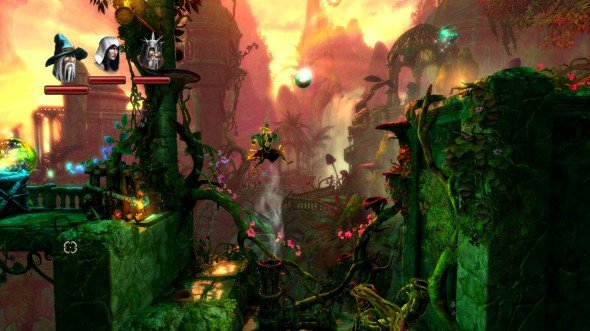Our Verdict
Trine 2 is far from mould-breaking, but the edges have all been smoothed and its lovelier than ever
PC Gamer's got your back
Trine 2 is less of a sequel, and more radical cosmetic surgery. Frozenbyte have exploded the formula into a beautiful, rainbow-sodden spectacle. You don't realise how few purple and green crystal-lit caverns there are out there, until you're forced to stop and bask in one.
Trine is a fairytale platforming adventure, based around a magical floating sconce that's bound together the souls of a wizard, a knight and a thief. The story itself is sweet enough – perfectly charming and a shade too earnest – but what really drives you, beyond the irresistible instinct in platformers to travel to the right, is the satisfaction that's gained from solving the inventive physics-based puzzles.
Playing solo, you can swap between characters instantly as you require their different skills. The Wizard can levitate objects, conjure boxes, and eventually planks, allowing him to bridge gaps and create steps. But he's all wizardy and crap in a fight, so tap him out when goblins and bosses appear.

The Thief can fire a grappling hook and swing from wooden surfaces, and her bow makes her the best ranged fighter. Then there's the Warrior, who dishes out the melee damage with his sword, deflects lava with his shield, and smashes delicate stuff from afar with his hammer.
If you've played the first game, you'll be thinking “well, this sounds pretty familiar. Shouldn't you be focusing on the new stuff?” The weakest thing about Trine 2 is how broadly identical it is to the first game. The energy bar has gone, and there's online co-op play, but Trine 2 amounts to a skill reset and a bunch of gorgeous new levels.
The flexibility of the puzzles and the overlapping powers mean that often there's no pure, one-way solution. In particular, the Thief's agility becomes less essential as the Wizard learns to conjure more simultaneous objects. Solo, this doesn't matter. Multiplayer changes the nature of the game.
First off, and this is such a superficial observation that I feel obliged to say it in a stupid way, it's nice to do a solve on a puzzle with a friend. The first Trine had local multiplayer, bizarrely hidden in a sub-sub-menu, but Trine 2 brings it to the main menu, and adds online matchmaking and text chat. It's now easy to drop into a game with strangers or pals.

More fundamentally, dividing the powers between three players, instead of one player swapping between the powers as he sees fit, means that progress that could only previously be made by one character now has to be achievable by all three. Frozenbyte have addressed this in two ways. Firstly, the Wizard can levitate items that he's standing on in multiplayer. But life's too easy with a magic carpet.
A more elegant solution is Unlimited mode. Tucked away in the 'host a game' options, this allows multiples of each class on screen. It's more chaotic, more flexible, and more fun. It solves some huffier moments, like when the Thief realises she's a complete spare wheel. And that moment where the Wizard decides to avoid a boss fight, hanging out by the partner-regenerating checkpoints while an endless stream of Thieves and Knights do the work.
Trine 2 may retread a lot of old ground, but it's beautiful. It's like Frozenbyte are saying “Oh, did we make Trine? We meant this.” The same moderate puzzling challenge, the same characters, the same charm and some problems fixed.
Trine 2 is far from mould-breaking, but the edges have all been smoothed and its lovelier than ever


